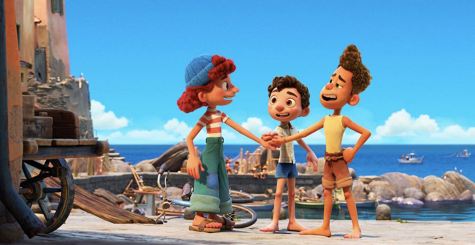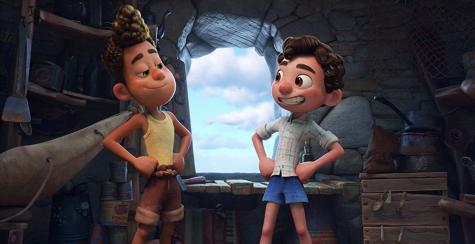REVIEW: ‘Luca’ is a simple flick that defies the traditional Pixar structure, for better or worse
Since its very beginning, Pixar has set itself apart in its masterful navigation of captivating storytelling and emotional intelligence. Films like “The Incredibles” “Ratatouille” and “Soul” are often described as movies made for adults that children can also enjoy due to the complexity of their themes. There is a certain indie quality to early Pixar films that Disney’s catalog does not quite replicate, due in part to Pixar’s willingness to take risks. They toy with unique concepts—toys that come alive, the monsters in the closet, the emotions in your head—and relate these to emotional truths in a way that avoids contrivances. It is a quality few other studios have replicated and has built up a reputation that attracts audiences with each new release.
“Luca” is this year’s newest addition to Pixar’s catalog, airing on Disney+ for free. Set on the Italian Riviera, young protagonist Luca Paguro, voiced by Jacob Tremblay, explores the quaint fictional village of Portorosso with newfound friend Alberto Scorfano, voiced by Jack Dylan Grazer in their search for a new life together. Their adventures lead them to befriend local Giulia Marcovaldo (Emma Berman) and her seafaring father Massimo (Marco Barricelli), but one secret threatens to ruin their summer if exposed: they are both sea monsters from a world below the surface, creatures hunted by the inhabitants of Portorosso. Hiding their identities, they navigate the human world with the goal of obtaining a Vespa, the one object that will ensure their freedom.

In animation quality, “Luca” is certainly up to par with its predecessors—while the underwater world is visually sparse, the characters and the seaside village are both beautiful to look at, with a fluid cartoonish style to them. However, this film is divergent from the other traditional elements of Pixar—namely, the plot and the emotional themes. It is more reminiscent of a Studio Ghibli film with a focus on whimsy, though not quite as refined.
The film lacks a clear plot for most of its run time, opting instead to focus on the relationships between its characters. This is its most compelling aspect—each character has a distinct personality from any other, and their relationship dynamics differ much like in real life. Luca and Alberto’s friendship, arguably the core of the film, is built on a unique understanding of one another’s dreams to live above the surface. Their jealousy-fueled conflict later on in the run time holds real emotional weight because of this. Luca and Giulia’s friendship blossoms out of their shared interest in learning, something that is unique to their characters. Even the relationship between Alberto and Mr. Marcovaldo is touching as a father-son dynamic develops between them. The best parts of the film revolve around these individual moments between characters, crafting the feel of reality in these grounded interactions.
However, this reality is often infringed upon by a goal-oriented plot that does not mesh with the indie feel of the character-central moments. Upon arriving at Portorosso, the boys discover that the prize money given to the winner of a local race would afford them a Vespa. They enter as a three-man team with Giulia, and what follows can only be described as “shenanigans” that give the characters something to do. It explains how they meet Giulia, how they plan on obtaining a Vespa, and how they are eventually uncovered as sea monsters by the community. This objective also comes a fourth of the way into the film, with the first section focusing on Luca’s relationship with his family and his burgeoning friendship with Alberto. This section is quite charming and introduces Luca’s main conflict, but said conflict is hardly brought up again in favor of the race. A lot of the introspection and growth that could be taking place is denied by the necessities of the plot, which is less compelling than the characters it involves. There is a lack of real tension until the climax too, hindering the sense of progression throughout its run time.

As far as emotional beats, though, “Luca” delivers. Each character has their own individual struggle, and the relationships they have established provide a space for them to confide in and grow with one another. These are not explored to an existential degree though, instead informing certain aspects of characterization. Their nature does not require them to be elaborate, as the majority of the characters are only kids.
However, the sea monster conflict is one of the core aspects of the story. Portorosso is a village ridden with anti-sea monster lore, a lot of its inhabitants being fishers. This creates some tension every time Luca and Alberto are close to being exposed, and even more so at the climax. They willingly reveal themselves in order to win the race, but when Mr. Marcovaldo gives a speech, the town immediately accepts them. A simple “be yourself” message on the surface, offers potential for some powerful subtext, but surprisingly this concept is not explored much. At no point does Luca wonder how it would affect his relationship with Giulia, what Mr. Marcovaldo would do to them or what the town as a whole would. Instead, it is left in its most basic form, allowing the viewer to interpret it to their liking. While the climax is resolved far too quickly, it reflects the simple story structure, providing some satisfaction in its recognition of the characters’ bond.
We have come to expect that Pixar’s films are a force to be reconned with, always packing a ground-shaking punch. “Luca” is certainly simpler than the average entry, with fairly basic story elements and emotional themes. However, it does not have to be more than that. As is, it is a wholesome adventure set in a beautiful idyllic town, targeted toward the age group of its own characters. Despite its plot-related weaknesses, this film is something that younger audiences may benefit from in its portrayal of positive, introspective relationships and a general message of acceptance. It is not likely to captivate adults the way its predecessors do, but it is a fun watch nonetheless for those who enjoy shenanigans with some soul.








